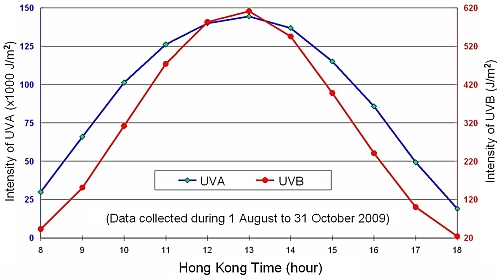What is UVA?
What is UVA?
LEUNG Wai-hung
March 2010
UV radiation can be further classified as UVA, UVB and UVC respectively, corresponding to their different wavelengths. UV radiation reaching the earth's surface consists of UVA and UVB only, as all UVC is absorbed by the atmosphere. Excessive exposure to UVB may lead to sunburn and is one of the major causes of skin cancer. Although the immediate effect of UVA to the skin is less prominent than that of UVB, over-exposure to UVA may lead to darkening, ageing and wrinkling of the skin, as well as potential development of skin cancer. Therefore, when choosing sunscreen lotions, we should select the one that can effectively block both UVA and UVB.
The Observatory has started measuring UVA at the King's Park Meteorological Station on an experimental basis since August 2009. Preliminary analysis showed that during the day, the change in intensity of UVA was less than that of UVB. This is because UVA has a longer wavelength and therefore scattering by air and water particles will be less prominent. This phenomenon is more pronounced in the morning and during sunset when the sun's elevation angle is small. For example, as shown in the following diagram, the intensity of UVB increased by more than 7 times as the suns elevation angle increased gradually from 8 a.m. to 10 a.m. The intensity of UVA only differed by about 3 times during the same period.

Diurnal variation of UVA and UVB